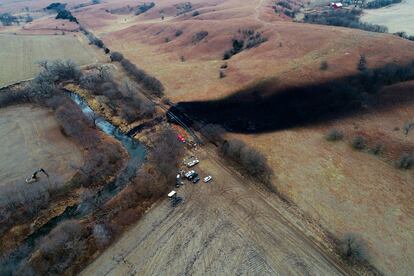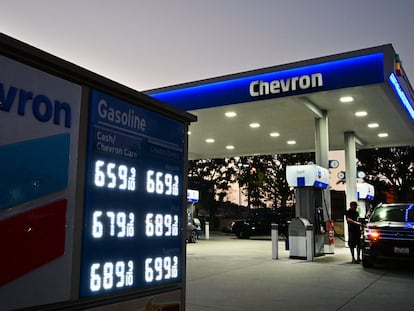Firm: Faulty weld, pressure on pipe led to Kansas oil spill
The company said the weld was for a fitting that connected two sections of pipe, and the fitting and weld came from a manufacturing plant

A faulty weld at a bend in an oil pipeline contributed to a spill that dumped nearly 13,000 bathtubs’ worth of crude oil into a northeastern Kansas creek, the pipeline’s operator said Thursday, estimating the cost of cleaning it up at $480 million.
Canadian-based TC Energy said the flawed weld caused a crack that then grew over time because of the stress on the bend in its Keystone pipeline system in rural pastureland in Washington County, about 150 miles (240 kilometers) northwest of Kansas City. The company said the weld was for a fitting that connected two sections of pipe, and the fitting and weld came from a manufacturing plant.
The company, which is responsible for overseeing inspections of its pipeline system, said it still is investigating the cause of the pipeline stress and is analyzing “other areas with potentially similar conditions.” The Dec. 7 rupture spilled nearly 13,000 barrels of crude oil, with each barrel containing 42 gallons, the size of a standard household bathtub.
“Our focus continues to be the safe operation of the pipeline system,” the company said in a statement.
No one was evacuated following the spill, and officials said it did not affect the two larger rivers and reservoir downstream. With federal regulators’ permission, the company reopened the affected segment a little more than three weeks after the spill, though at a lower pressure than before.
But Bill Caram, executive director of the advocacy group Pipeline Safety Trust, said it’s “troubling” that TC Energy said the flawed weld came from a “fabrication facility.” He said conditions there should have been ideal for making a weld that would not fail — as opposed to welding in the field.
Caram also said pipeline companies and pipeline regulators in the U.S. Department of Transportation struggle to deal with a combination of multiple threats that on their own don’t appear to need immediate attention but together add up.
“The threats aren’t in a vacuum,” Caram said. “This leads to the need for more sophistication in the way operators are mitigating against their threats, looking at how they interact with each other.”
The spill was the largest onshore in nine years and larger than than 22 previous spills on the Keystone system combined, according to U.S. Department of Transportation data. That’s even though the company decreased its estimate for its size from its initial figure of 14,000 barrels.
Zack Pistora, who lobbies the Kansas Legislature for the Sierra Club, argued that the company’s explanation shows the pipeline’s design was flawed. In July 2021, a U.S. Government Accountability Office report said the four biggest previous spills on the Keystone system were caused by issues tied to its original design, its construction or the manufacturing of the pipe.
The company’s statement Thursday said an analysis of the pipeline’s metal showed no issues with it or its strength.
The Kansas House energy committee plans to have hearings on the oil spill in March, according to its chair, state Rep. Leo Delperdang, a Wichita Republican whose career includes a stint with a pipeline company.
“I’ve got lots of questions,” he said.
The 2,700-mile (4,345-kilometer) Keystone system carries heavy crude oil extracted from tar sands in western Canada to the Gulf Coast and to central Illinois.
Concerns that spills could pollute waterways spurred opposition to plans by TC Energy to build another crude oil pipeline in the same system, the 1,200-mile (1,900-kilometer) Keystone XL, across Montana, South Dakota and Nebraska. President Joe Biden’s cancelation of a permit for the project led the company to pull the plug on the project in 2021.
Pistora argued that people don’t have any real assurances that the existing Keystone pipeline won’t “fail again.”
“It should be unsettling to everyone along the pipeline path and to Americans generally,” he said.
Local farmer Bill Pannbacker said the rupture occurred near his property line, spraying crude onto his pasture at a point after the pipe goes under a creek and starts to ascend an 80-foot (24-meter) hill. He suggested that a straight section of pipe would be less prone to problems but added, “I’m not an engineer.”
Pannbacker said crews swarmed over the area as they cleaned up the mess, aided by relatively dry weather. The company said its estimate for the cost of the cleanup may change, calling its commitment to the work “unwavering.”
“It is like a little city out there,” said Pannbacker, also a former Kansas House member. “I just went by last night, and the lights get your attention, but I mean, they’re working hard.”
Sign up for our weekly newsletter to get more English-language news coverage from EL PAÍS USA Edition
Tu suscripción se está usando en otro dispositivo
¿Quieres añadir otro usuario a tu suscripción?
Si continúas leyendo en este dispositivo, no se podrá leer en el otro.
FlechaTu suscripción se está usando en otro dispositivo y solo puedes acceder a EL PAÍS desde un dispositivo a la vez.
Si quieres compartir tu cuenta, cambia tu suscripción a la modalidad Premium, así podrás añadir otro usuario. Cada uno accederá con su propia cuenta de email, lo que os permitirá personalizar vuestra experiencia en EL PAÍS.
¿Tienes una suscripción de empresa? Accede aquí para contratar más cuentas.
En el caso de no saber quién está usando tu cuenta, te recomendamos cambiar tu contraseña aquí.
Si decides continuar compartiendo tu cuenta, este mensaje se mostrará en tu dispositivo y en el de la otra persona que está usando tu cuenta de forma indefinida, afectando a tu experiencia de lectura. Puedes consultar aquí los términos y condiciones de la suscripción digital.
More information
Archived In
Últimas noticias
Most viewed
- David King, chemist: ‘There are scientists studying how to cool the planet; nobody should stop these experiments from happening’
- Reinhard Genzel, Nobel laureate in physics: ‘One-minute videos will never give you the truth’
- Mexico completes its trade shift with the entry into force of tariffs on China and countries without trade agreements
- Oona Chaplin: ‘I told James Cameron that I was living in a treehouse and starting a permaculture project with a friend’
- Sinaloa Cartel war is taking its toll on Los Chapitos










































